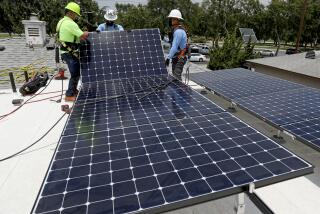Some Factors to Consider Before Going Solar
- Share via
Roof requirements: You need as little as 50 square feet for a starter system and as much as 500 to 1,000 square feet for one capable of meeting all a home’s energy needs. A square foot of single or poly-crystalline silicon module area produces 10 watts of power in bright sunshine. So a 1,000-watt system needs 100 to 200 square feet of roof.
Composition shingle roofs are the easiest to work with; slate the most difficult. Shake roofs, flat concrete tile and mission tile roofs fall in between.
Importance of sun: Shade is a killer and cloudy days cut efficiency to 10% of full output. A south-facing roof is best.
State law says your neighbor’s tree can’t block the sun from getting to your solar panels.
Cost factors: Costs vary wildly due to differences in energy consumption. $8,000 a kilowatt of solar capacity is a good benchmark. So a 2-kilowatt system would cost about $16,000.
The state Energy Commission manages an $84-million fund (paid for by utility ratepayers) that covers up to half the costs of a solar system. Contact the energy call center, (800) 555-7794. Los Angeles Department of Water and Power customers aren’t eligible but the DWP has a similar program. Call the department at (800) GREEN-LA.
Finding a solar provider: The Energy Commission and the California Solar Energy Assn. (https://www.calseia.org) provide lists. Ask questions and go with a company that has experience.
Getting connected: Contact your utility for an interconnection agreement and a purchase and sales agreement so you can trade solar power for utility power when you need it.
(Sources: California Energy Commission and Don Loweburg, Offline Independent Energy Systems.)
More to Read
Inside the business of entertainment
The Wide Shot brings you news, analysis and insights on everything from streaming wars to production — and what it all means for the future.
You may occasionally receive promotional content from the Los Angeles Times.










